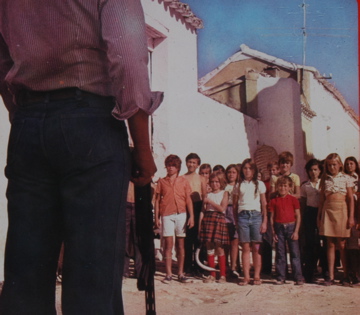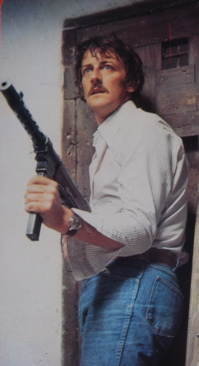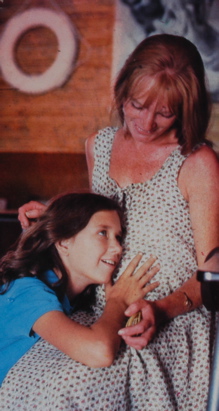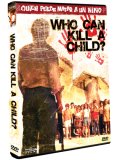| Reviews & Columns |
|
Reviews DVD TV on DVD Blu-ray 4K UHD International DVDs In Theaters Reviews by Studio Video Games Features Collector Series DVDs Easter Egg Database Interviews DVD Talk Radio Feature Articles Columns Anime Talk DVD Savant Horror DVDs The M.O.D. Squad Art House HD Talk Silent DVD
|
DVD Talk Forum |
|
|
| Resources |
|
DVD Price Search Customer Service #'s RCE Info Links |
|
Columns
|
|
|
Who Can Kill a Child?
Spanish movies of the seventies range from schlock exploitation to exploitation of a rather high quality level. Narciso Ibáñez Serrador's well directed Who Can Kill a Child? aka ¿Quién puede matar a un niño? leans toward the better half and produces several interesting surprises.
The movie is a smart blend of ideas from Night of the Living Dead, Village of the Damned and The Birds. The then new hit Jaws probably provided the oomph (a holiday beach setting) to interest investors. The film has an excellent narrative flow; its main flaw is a fashionably pessimistic attitude that makes the ending all too predictable.

Who Can Kill a Child? has a notorious release history, and fans aware of its existence in several truncated versions have been hoping for a definitive original version. Director Narciso Ibáñez Serrador specialized in Television but has a strong reputation based on this horror film and 1969's La residencia aka The House that Screamed a psycho-murder tale. Who Can Kill a Child? makes a play for greater significance. A disturbing opening title montage cut from many original release versions shows a parade of war atrocities against children from WW2 to Biafra. Stills and movies make the point that innocent children, bombed and starved by the millions, pay the price for every national conflict. Serrador begins his movie by transitioning from a B&W photo of a near skeletal child victim, to a color shot of fat and happy kids enjoying the beach. We quickly catch on when our 'normal' tourist couple encounter sinister kids in the sun-baked streets of Almanzora.
The film's paranoid pattern was probably as predictable in 1976 as it is now, but Serrador's likeable actors and his careful direction keep things interesting. Tom says that most of the population must be elsewhere celebrating, like the folks on the mainland, the kind of dumb assumption that one uses when things don't add up. The feeling of "almost-normality" causes us to jump several times when barely-seen figures dart into hiding in the background, and we can understand Tom and Evelyn not bolting back to their boat until it's too late. Who would expect all the children to suddenly become feral killers? Tom picks out some lunch snacks in an empty grocery, not seeing the dead owner lying on the other side of a display case. He then witnesses a brutal killing. Kids use an old man's battered body as a piñata, laughing as they bash it with farm implements.

The killer kids are handled in an interesting way. Instead of being inscrutable or contemptuously superior, like the blonde aliens in Village of the Damned, they appear to be possessed with a communicable desire to band together to slaughter adults. The boys are sullen and contrary while the girls grin with the diabolical secret of their conspiracy. Both sexes fight like savages. They are also shaken when one of their own is injured, and we realize that the spirits in possession must belong to the countless children murdered by adults. It's a crude concept never explicitly spelled out, and we wonder why kids on a particular island should be the first affected, except to conform to the old Sci-fi convention decreeing that catastrophes all begin in remote localities. When Tom faces the murderous kids with a machine gun (the film's potent key image) one girl is tenderly holding a baby. This isn't just an outbreak of mass insanity, it's war.
The movie is violent but nothing compared to horror movie standards, unless the very idea of children being battered and shot down is too much to take. There is one morally objectionable scene of a group of boys playfully disrobing the corpse of a German woman. Beyond the nightmare aspect, the film disturbs because we're encouraged to confront the taboo of harming children. In these absurd circumstances, slaughtering children is a good idea. That conflicts with the film's avowed theme, outrage at the killing of children in wars.
Serrador's story (he says that the credited source novel was written from his script, not vice versa) has two remarkable scenes. In the first, the killer kids from the main village come upon several "unaligned" children at an outlying house. By simply making eye contact and staring, the new kids become part of the flock. This makes the film all the more apocalyptic, when we think that the kids might escape Almanzora to the mainland, and spread the slaughter around the planet. The second key scene is worthy of David Cronenberg. A grinning village girl embraces Evelyn's pregnant body, and when she later feels horrible pains, Evelyn realizes that her own unborn child is trying to kill her. It's a powerful acting moment for Prunella Ransome and Serrador keeps it from going over the top or becoming risible.  Who Can Kill a Child? moves from there to a violent, George Romero- style finish, yet remains satisfying. It's just serious enough to make us think about a world gone so bad that our own children revolt against us. Even if Serrador is expressing a conservative, "blame the kids" attitude, the movie works.
Who Can Kill a Child? moves from there to a violent, George Romero- style finish, yet remains satisfying. It's just serious enough to make us think about a world gone so bad that our own children revolt against us. Even if Serrador is expressing a conservative, "blame the kids" attitude, the movie works.
Dark Sky/MPI's DVD of Who Can Kill a Child? treats this rewarding Euro-horror treat with the kind of respect we wish all of our top Missing In Action films could receive. The transfer is of original elements and looks nearly perfect, with even the red script titles remaining sharp and solid. The clear audio highlights Waldo de los Ríos' expressive, smartly utilized score.
The movie comes with two audio tracks, a split English-Spanish track and a full Spanish version. Both are carefully recorded but I recommend the first, as the English tourists speak in their own language. Several script situations are based on miscommunication, as would be normal for strangers in a foreign country.
The extras include an extensive still and artwork gallery and two interview featurettes produced by David Gregory. Barcelona native Miguel F. Graciani conducts the interviews, in Spanish. Cameraman José Luis Alcaine is now a world-class talent doing top work for Pedro Almodóvar, like last year's Volver. He explains that "Almanzora" was really three or four locations spread all across Spain: in 1976 tall modern buildings ringed every quaint little harbor. Director Serrador appears in a second interview. Graciani made several trips to Madrid only to find the director too ill to be filmed, and the session was repeatedly cancelled. The deadline came and went. Graciani persisted nevertheless, and secured the interview months later. As it turned out, the production of the DVD had been delayed as well, and David Gregory was able to put the piece together at the last moment. Señor Serrador looks subdued but does not show what poor health he's in, and the interview is a good one. After ¿Quién puede matar a un niño? he never made another horror feature.
On a scale of Excellent, Good, Fair, and Poor, Who Can Kill a Child? rates:
Movie: Very Good
Video: Excellent
Sound: Excellent original English/Spanish track and full-Spanish track
Supplements: Interview featuretes with cameraman José Luis Alcaine and director Narciso Ibáñez Serrador; still gallery.
Packaging: Keep case
Reviewed: May 24, 2007
Reviews on the Savant main site have additional credits information and are more likely to be updated and annotated with reader input and graphics.
|
| Popular Reviews |
| Sponsored Links |
|
|
| Sponsored Links |
|
|
| Release List | Reviews | Shop | Newsletter | Forum | DVD Giveaways | Blu-Ray | Advertise |
|
Copyright 2024 DVDTalk.com All Rights Reserved. Legal Info, Privacy Policy, Terms of Use,
Manage Preferences,
Your Privacy Choices | |||||||











